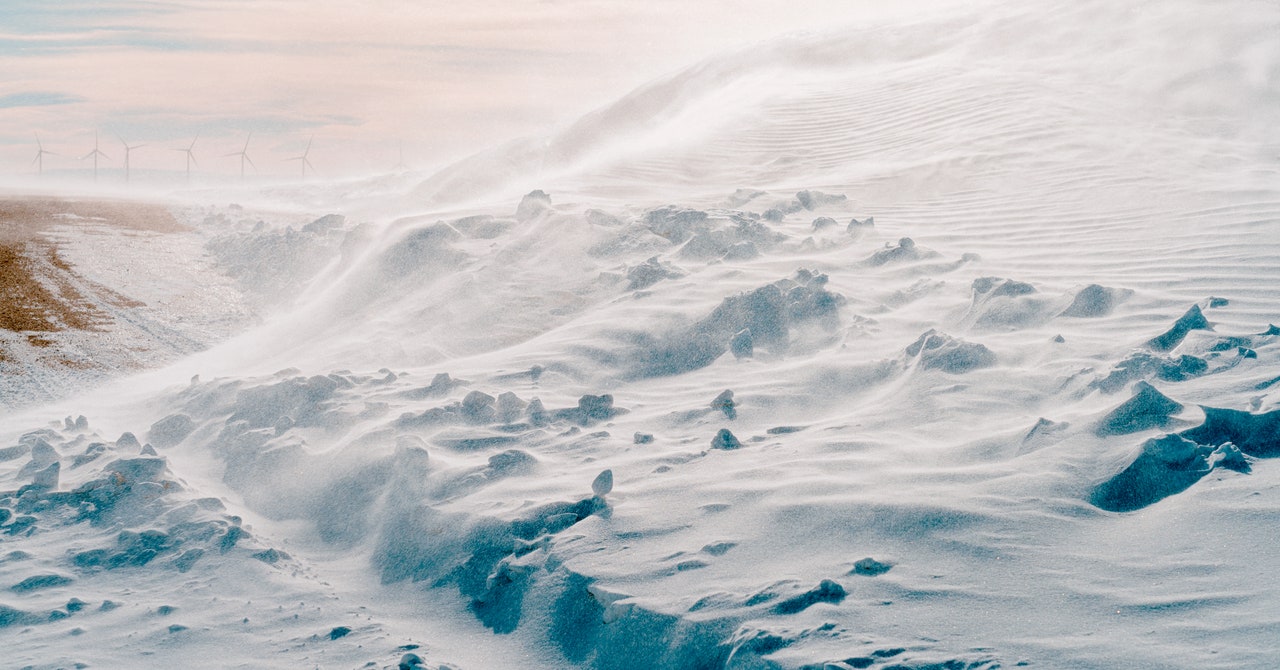A massive wind turbine rises into the air about 60 yards from where I stand. Silhouetted against an endless blue sky, the structure is taller than the Statue of Liberty, and the tips of its three blades spin more than 150 miles per hour, fast enough to complete one revolution every four seconds or so. Looking up at it from the ground is disorienting; I feel as if I’ve shrunk. Even the Ford F-250 pickup I’m about to climb into—one of those monsters with a roaring engine and an extra bar to help you step up into the cab—seems miniature. I listen, but if the turbine itself is making a hum or whir, I can’t hear it over the relentless pounding of the wind, a white noise accompanied by the sound of the air snapping against the loose fabric of my jacket.
Opposite me, on the driver’s side of the pickup, is Laine Anderson, director of wind operations at PacifiCorp, a public utility company that powers more than 140,000 square miles across six Western states. As I move to hop in the truck, Anderson cautions me to watch my door. He’s never actually seen one blow off a vehicle, but PacifiCorp does cover the possibility in safety training.
See more from The Climate Issue | April 2020. Subscribe to WIRED.
Illustration: Alvaro DominguezThe wind farm we’re touring today is called Glenrock, one of nine that PacifiCorp operates in Wyoming; they are among the more ideally situated wind farms in the US. Wyoming’s topography—a series of mountain ranges and plateaus spread diagonally across the state—creates a sort of natural funnel. In some towns near the end of that funnel, the gusts are so strong and persistent that trees noticeably lean to the east. In fact, the wind blows harder and with more regularity here in south-central Wyoming than just about anywhere else in the US. And yet compared to Texas, Iowa, California, and several areas across the Great Plains, Wyoming lags far behind in wind development, ranking 16th for installed wind capacity. Glenrock stands in a state where renewable energy has been, if not quite embattled, then stigmatized and viewed with contempt. And the reason for this cold reception is, in a way, written on the landscape of Glenrock itself.
Anderson shifts the truck into gear and starts up a hill. Up high, you get a better sense of the wind farm’s scope: 158 steel turbines that look like pinwheels copied and pasted into neat rows across 14,000 acres. You also get a sense of its backstory. Constructed in 2008, Glenrock was the first wind farm in the country to be built on top of a reclaimed coal mine—a feat of modern engineering that doubles as a particularly on-the-nose metaphor for the transformation that Wyoming has been reluctant to embrace. “Right here on our left, this was an open pit,” Anderson says, pointing to a rolling field.
Wyoming’s attachment to fossil fuels runs deep. For more than a century, roughnecks have been scraping through layers of Wyoming’s topsoil, mining coal and drilling for oil. In the 1980s, the state’s coal sometimes accounted for a quarter of the energy consumed by the entire country. Coal mining jobs brought pride and a middle-class lifestyle. Taxes and royalty payments from subterranean resources have paved the state’s roads and built its schools. So when the wind industry came along, it was greeted by many with a mix of uncertainty (because it was new), derision (because it was “green”), and fiscal opportunism (because energy has always been the state’s golden goose).
Many of the people who work in Wyoming’s wind sector have themselves made the transition from livelihoods defined by fossil fuels. Anderson graduated from the University of Wyoming with a degree in petroleum engineering in 1984 and then, as he put it, “drilled wells from North Dakota clear down to Arizona.” That lasted about five years, before the region’s oil industry went bust. Anderson spent the next two decades on dude ranches, entertaining tourists on horseback rides and fly-fishing adventures. When he and his wife sent their two kids off to college, he started looking for a new challenge. PacifiCorp happened to have an opening in renewables. “So that’s what we did,” he says. His first job was to help build Glenrock.
Casey Collins, who is Glenrock’s day-to-day manager, is riding along in the pickup for the wind farm tour. He too was a former oil-field worker, and I wondered if the guys from his oil days give him a hard time for taking a job in renewables. “I get shit all the time!” he tells me. “Most of it’s based on misconceptions and ignorance, to be honest. I’ve been asked several times, ‘How much natural gas do you have to pump up there to get those things spinning?’”
Wind turbines turn at PacifiCorp’s Glenrock facility outside of Casper, Wyoming.
Photograph: Cody CobbJust over a decade ago, in the late 2000s, the wind prospectors arrived in Wy

